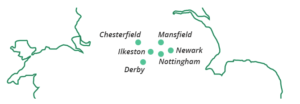Application to exclude evidence before Nottingham Youth Court
Nottingham criminal defence solicitor Nick Walsh recently represented at a Nottingham youth court trial. The identification evidence was disputed and Nick made an application to exclude evidence from a police officer.
Nick’s client was fourteen year old charged with theft of a motorbike from a domestic garage. A police officer purported to identify Nick’s client from The evidence was that he had been identified from CCTV footage by a police officer who our client very well.
Identification evidence from CCTV footage
An identification in such circumstances is governed by the Codes of Practice set out under Police and Criminal Evidence Act 1984. As a result, following the not guilty plea being entered, Nick wrote to the Crown Prosecution Service asking that they disclose the contemporaneous notes of the CCTV viewing and the additional records required by Code D of the Codes of Practice.
The prosecution did not supply any of the documentation that had been requested. The officer did, however, give a further statement dealing with the circumstances of the identification.
Expert cross examination of a police witness
At trial Nick had the opportunity of asking the officer questions about the circumstances of the identification. His careful cross examination led the officer to concede that he had not kept any records or notes of his viewing of the CCTV. Additionally he could not be sure how many times he had viewed the footage. More damagingly he confirmed that he had been given that task of viewing the CCTV by his sergeant and had been told that Nick’s client was already suspected of the crime.
The officer stated that he had based his identification on the way the suspect walked. Having been made to view the footage again in court he had to accept that there was nothing distinguishing about the walk.
He also accepted that he had made his mind up that it was Nick’s client before he got a look at the offenders face. Finally, he had to accept that the quality of the CCTV footage was poor.
Application to exclude evidence obtained unfairly
At the close of the prosecution case Nick applied to the Youth Court Magistrates’ to exclude the identification evidence. This application was made under section 78 Police and Criminal Evidence Act 1984. This is on the basis of the breaches of the Codes of Practice. In this case, where the identification evidence was the only evidence in the case, it would be unfair to admit it.
The Magistrates agreed and the evidence was excluded. As a result, the prosecution had no option but to offer no further evidence and Nick’s client was found not guilty.
Client had the benefit of free criminal legal aid
Owing to our client’s age Nick’s representation of him was free of charge to both him and his parents under the criminal legal aid scheme
Contact an expert criminal defence lawyer
This case illustrates the importance of knowing the law that governs identification evidence. It also shows that you need a criminal solicitor on your side who can make sure that a police office is made to answer the difficult questions. This might open the door to an application to exclude evidence.

Nick can be contacted on 0115 9599550. Alternatively contact one of our other criminal defence solicitors at our offices across the East Midlands. A contact form is below too.

